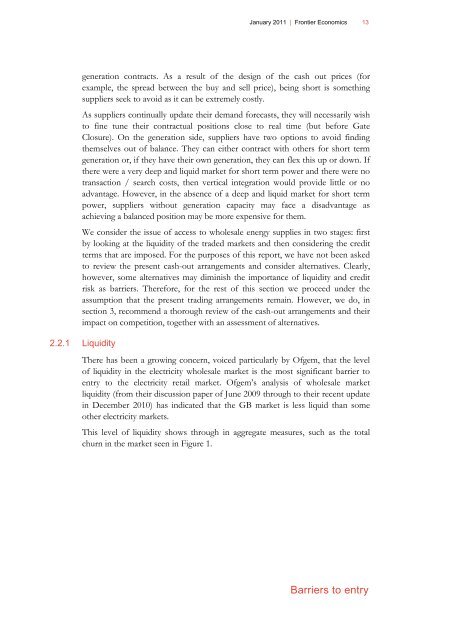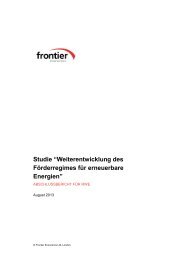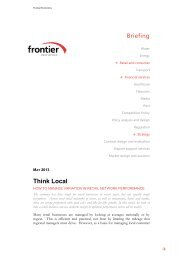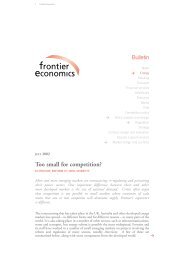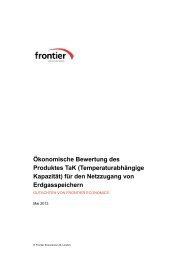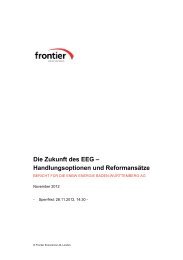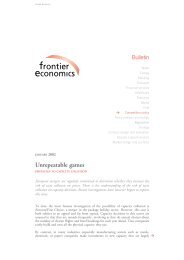competition and entry in the gb electricity retail market.pdf - Frontier ...
competition and entry in the gb electricity retail market.pdf - Frontier ...
competition and entry in the gb electricity retail market.pdf - Frontier ...
You also want an ePaper? Increase the reach of your titles
YUMPU automatically turns print PDFs into web optimized ePapers that Google loves.
January 2011 | <strong>Frontier</strong> Economics 13<br />
generation contracts. As a result of <strong>the</strong> design of <strong>the</strong> cash out prices (for<br />
example, <strong>the</strong> spread between <strong>the</strong> buy <strong>and</strong> sell price), be<strong>in</strong>g short is someth<strong>in</strong>g<br />
suppliers seek to avoid as it can be extremely costly.<br />
As suppliers cont<strong>in</strong>ually update <strong>the</strong>ir dem<strong>and</strong> forecasts, <strong>the</strong>y will necessarily wish<br />
to f<strong>in</strong>e tune <strong>the</strong>ir contractual positions close to real time (but before Gate<br />
Closure). On <strong>the</strong> generation side, suppliers have two options to avoid f<strong>in</strong>d<strong>in</strong>g<br />
<strong>the</strong>mselves out of balance. They can ei<strong>the</strong>r contract with o<strong>the</strong>rs for short term<br />
generation or, if <strong>the</strong>y have <strong>the</strong>ir own generation, <strong>the</strong>y can flex this up or down. If<br />
<strong>the</strong>re were a very deep <strong>and</strong> liquid <strong>market</strong> for short term power <strong>and</strong> <strong>the</strong>re were no<br />
transaction / search costs, <strong>the</strong>n vertical <strong>in</strong>tegration would provide little or no<br />
advantage. However, <strong>in</strong> <strong>the</strong> absence of a deep <strong>and</strong> liquid <strong>market</strong> for short term<br />
power, suppliers without generation capacity may face a disadvantage as<br />
achiev<strong>in</strong>g a balanced position may be more expensive for <strong>the</strong>m.<br />
We consider <strong>the</strong> issue of access to wholesale energy supplies <strong>in</strong> two stages: first<br />
by look<strong>in</strong>g at <strong>the</strong> liquidity of <strong>the</strong> traded <strong>market</strong>s <strong>and</strong> <strong>the</strong>n consider<strong>in</strong>g <strong>the</strong> credit<br />
terms that are imposed. For <strong>the</strong> purposes of this report, we have not been asked<br />
to review <strong>the</strong> present cash-out arrangements <strong>and</strong> consider alternatives. Clearly,<br />
however, some alternatives may dim<strong>in</strong>ish <strong>the</strong> importance of liquidity <strong>and</strong> credit<br />
risk as barriers. Therefore, for <strong>the</strong> rest of this section we proceed under <strong>the</strong><br />
assumption that <strong>the</strong> present trad<strong>in</strong>g arrangements rema<strong>in</strong>. However, we do, <strong>in</strong><br />
section 3, recommend a thorough review of <strong>the</strong> cash-out arrangements <strong>and</strong> <strong>the</strong>ir<br />
impact on <strong>competition</strong>, toge<strong>the</strong>r with an assessment of alternatives.<br />
2.2.1 Liquidity<br />
There has been a grow<strong>in</strong>g concern, voiced particularly by Ofgem, that <strong>the</strong> level<br />
of liquidity <strong>in</strong> <strong>the</strong> <strong>electricity</strong> wholesale <strong>market</strong> is <strong>the</strong> most significant barrier to<br />
<strong>entry</strong> to <strong>the</strong> <strong>electricity</strong> <strong>retail</strong> <strong>market</strong>. Ofgem’s analysis of wholesale <strong>market</strong><br />
liquidity (from <strong>the</strong>ir discussion paper of June 2009 through to <strong>the</strong>ir recent update<br />
<strong>in</strong> December 2010) has <strong>in</strong>dicated that <strong>the</strong> GB <strong>market</strong> is less liquid than some<br />
o<strong>the</strong>r <strong>electricity</strong> <strong>market</strong>s.<br />
This level of liquidity shows through <strong>in</strong> aggregate measures, such as <strong>the</strong> total<br />
churn <strong>in</strong> <strong>the</strong> <strong>market</strong> seen <strong>in</strong> Figure 1.<br />
Barriers to <strong>entry</strong>


